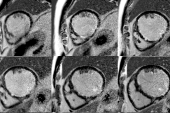PCI Doesn’t Cut Arrhythmias in Severe LV Dysfunction: REVIVED-BCIS2 Analysis
The results, experts say, suggest guidelines on the timing of ICD implantation should change to better protect patients with CAD.

PCI doesn’t reduce arrhythmia risks in patients with severe LV dysfunction and extensive coronary disease, according to a prespecified analysis of the REVIVED-BCIS2 trial. The results call into question current guideline recommendations around when to consider device therapy in this population with a high risk of sudden cardiac death.
Compared with optimal medical therapy alone (including devices as indicated), the addition of PCI did not reduce a composite of all-cause mortality or aborted sudden death, or a number of other arrhythmia-related outcomes, researchers led by Divaka Perera, MD (King’s College London, England), report in a study published online last week in Circulation.
Along with the main results of the trial reported a year ago, these findings suggest that it might be time to change guidelines, which recommend a 90-day waiting period after revascularization to see whether LVEF improves—presumably lowering the hazard of ventricular arrhythmias—before deciding on insertion of an implantable cardioverter-defibrillator (ICD), study author Holly Morgan, MBBCh (King’s College London), told TCTMD.
“In a stable population, we’d say that clinicians shouldn’t be pursuing PCI solely for the purpose of reducing arrhythmic risk. . . . We don’t believe there’s evidence to support that decision,” Morgan said. “And probably more importantly, if somebody does meet the criteria to have an ICD inserted, we don’t think that there’s any mandate now or any evidence to suggest that you should wait for any period to do that ICD, and, in fact, we think you could put a patient at risk of death if you left them unprotected for a time period by pursuing that strategy.”
Arrhythmic Risk in REVIVED-BCIS2
When the main results of REVIVED-BCIS2 were published, there was a hint that even though PCI failed to reduce the risk of all-cause death or hospitalization for heart failure, it might have lowered the rate of appropriate ICD therapies. The current prespecified analysis delves deeper into potential differences in arrhythmias between the two trial arms.
The trial, conducted across 40 UK centers, included 700 patients (mean age 69 years; 88% men) who had severe LV dysfunction (LVEF 35% or lower), extensive coronary disease, and viable myocardium. All patients were treated with optimal medical and device therapy, with the decision on use of an ICD and/or cardiac resynchronization therapy (CRT) left to the discretion of the local heart teams. Median LVEF at baseline was 28%, and slightly more than half of patients (53.1%) had an ICD or CRT implanted either before or during the study.
It’s going to be harder to justify a waiting period in these stable patients post-PCI, because we now know that you’re leaving that patient potentially unprotected. Holly Morgan
The primary outcome for the current analysis was a composite of all-cause death or aborted sudden death (defined as appropriate ICD therapy or a resuscitated cardiac arrest). Through a median follow-up of 41 months, there was no difference in this outcome between the PCI and control arms (41.6% vs 40.2%; adjusted HR 1.02; 95% CI 0.81-1.29). The results were consistent across subgroups.
There were no differences between groups for either of the individual components of that endpoint, or for CV death/aborted sudden death, appropriate ICD therapy/sustained ventricular arrhythmia, or the number of appropriate ICD therapies.
All of the results were similar in a sensitivity analysis focused on the patients who had an ICD and/or CRT device implanted before randomization or within the first 90 days of follow-up.
Clinical Impact
The suggestion of an arrhythmic benefit seen in the main REVIVED-BCIS2 trial results was not borne out in this fuller analysis, and “we just find that really valuable to show because it really will change current practice and it does challenge our current thinking,” Morgan said.
Together, what the main results and these new data “have shown now is that above optimal medical therapy, PCI doesn’t improve your ejection fraction—the median improvement in the main trial at a year was 4%, and that was the same in both groups,” she said. “We’ve also shown that the rate of death and of arrhythmias in this cohort is really high. So I think at the moment with this new data, it’s going to be harder to justify a waiting period in these stable patients post-PCI, because we now know that you’re leaving that patient potentially unprotected for up to 3 months, or even longer if there’s a waiting list for device insertion.”
Brett Atwater, MD (Inova Health System, Fairfax, VA), who was not involved in the study, said he was somewhat surprised that PCI didn’t reduce arrhythmia risk because of how these types of patients have been treated over the last 20 years. “Historically what we’ve done is simultaneously optimized medical therapy and evaluated for ongoing areas of ischemia and then considered revascularization options. Only after both of those were done would we consider an ICD implant in those patients who still had a low ejection fraction and symptomatic heart failure,” Atwater explained to TCTMD.
“What this study showed us is that optimal medical therapy is clearly important but that revascularization may not improve the ejection fraction and may not reduce the frequency of ventricular arrhythmia and sudden death,” he continued. “Therefore, we really should probably prioritize the CRT rather than revascularization options once medical therapy has been optimized.”
I think prioritizing ICD over revascularization in that waiting period can help save lives. Brett Atwater
Atwater said he thinks these data are strong enough to get the community thinking about changing the guidelines. “I think that delay to ICD results in unnecessary deaths,” he said, noting that he has seen patients die suddenly while waiting for revascularization. Moreover, studies of wearable ICDs have confirmed that there is a risk of sudden death during this waiting period. “So I think prioritizing ICD over revascularization in that waiting period can help save lives,” said Atwater. “I think guidelines should be changed in response to this article.”
The paper also highlights a phenomenon observed around the world—the underutilization of ICDs, he added. That only a little more than half of the trial participants ended up with an ICD or CRT device “is sort of a reminder to all of us that we need to prioritize the ICD, particularly in light of the data that were presented in this,” Atwater said. “[I would have] hoped that we’d see higher utilization rates in this really sick population with the ejection fraction less than 35% and evident coronary disease.”
Todd Neale is the Associate News Editor for TCTMD and a Senior Medical Journalist. He got his start in journalism at …
Read Full BioSources
Perera D, Morgan HP, Ryan M, et al. Arrhythmia and death following percutaneous revascularization in ischemic left ventricular dysfunction: prespecified analyses from the REVIVED-BCIS2 trial. Circulation. 2023;Epub ahead of print.
Disclosures
- The trial was sponsored by King’s College London and funded by the National Institute for Health and Care Research Health Technology Assessment Program. The arrhythmia analyses were supported by the British Heart Foundation.
- Perera and Morgan report no relevant conflicts of interest.





Comments